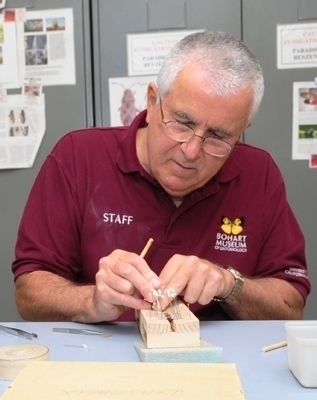
No, as industrious as a Lepidopterist.
Specifically, as industrious and dedicated as Jeff Smith, curator of the moth and butterfly collection at the UC Davis Bohart Museum of Entomology--a collection that an international authority on Lepidoptera praised as “The Gold Standard” of Lep collections.
But more about that later.
Smith, fascinated by insects since his childhood in San Jose, considers entomology “my passion” and the Bohart Museum “my cause.”
You may remember him from back in 2015, when he received a highly competitive Friend of the College Award from the UC Davis College of Agricultural and Environmental Sciences.
Lynn Kimsey, then director of the Bohart Museum and a UC Davis professor of entomology (and now distinguished professor emerita) nominated Smith for the award. “You could not ask for a better friend than Jeff Smith,” she said, noting that he has “brought us international acclaim and saved us $160,000 through donations of specimens and materials, identification skills and his professional woodworking skills. This does not include the thousands of hours he has donated in outreach programs that draw attention to the museum, the college and the university.”
Kimsey, who directed the museum for 34 years, stepping down on Feb. 1, 2024 when Professor Jason Bond accepted the position, remembers when Smith joined the museum. “When Jeff was working for Univar Environmental Services, a 35-year career until his retirement in 2013, he would spend some of his vacation days at the museum. Over the years Jeff took over more and more of the curation of the butterfly and moth collection. He took home literally thousands of field pinned specimens and spread their wings at home, bringing them back to the museum perfectly mounted. To date he has spread the wings on more than 200,000 butterflies and moths. This translates into something like 33,000 hours of work!”
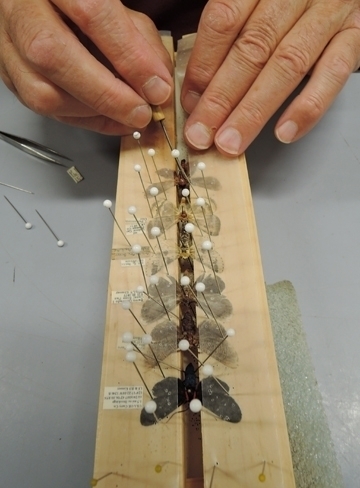
We caught up with Smith the other day for an update.
A Bohart volunteer since 1998, Smith has donated some 100,000 specimens (primarily butterflies, moths but a few other insects, including beetles) to the Bohart Museum. To date, he has spread the wings of some 180,000 moth and butterflies. He has crafted and donated some 2,475 wooden specimen drawers. He is valued for his expertise and public outreach at the Bohart Museum's open houses, usually about nine in number. The open houses include UC Davis Picnic Day, UC Davis Biodiversity Museum Day, and Take-Your-Daughters-and-Sons-to-Work Day.
In addition, Smith annually presents an evening spreading class to the UC Davis Entomology Club as well as an annual presentation to Bio Boot Camp. He also speaks at 12 to 15 other venues per year, engaging students at School Science Days and in individual classrooms.
825,454 Specimens in Lep Collection. “We have 825,454 specimens of moths and butterflies,” he said, delighted to be showing the collection at the Bohart Museum's Moth Night from 7 to 11 on Saturday, July 20, in celebration of National Moth Week. “We have around 618,750 moths, ranging in size from the huge Atlas moths (10-inch wingspan) to the extremely tiny (4 mm wingspan) leafminer moths.” The event is free and family friendly.
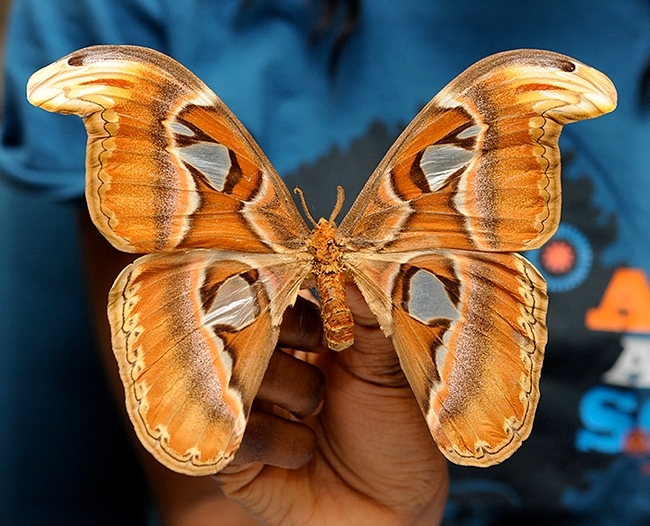
Some of his favorite moths are in the subfamily Arctiinae. "They're called Tiger Moths because of their colors and amazing ability to resemble stinging wasps. We have a very large worldwide collection of this group.”
Worldwide, scientists have described about 18,000 species of butterflies and 180,000 species of moths, "and hundreds of newly named species are added every year," Smith said. "It's also believed that we may know of no more than 10-15 percent of the species actually out there, with the small 'micro-Lepidoptera' likely with over 90 percent of the species in the world still unknown. This emphasizes the importance of preserving natural environments so things don't go extinct before we can ever recognize their importance to the Earth and their relationships in their habitats. '
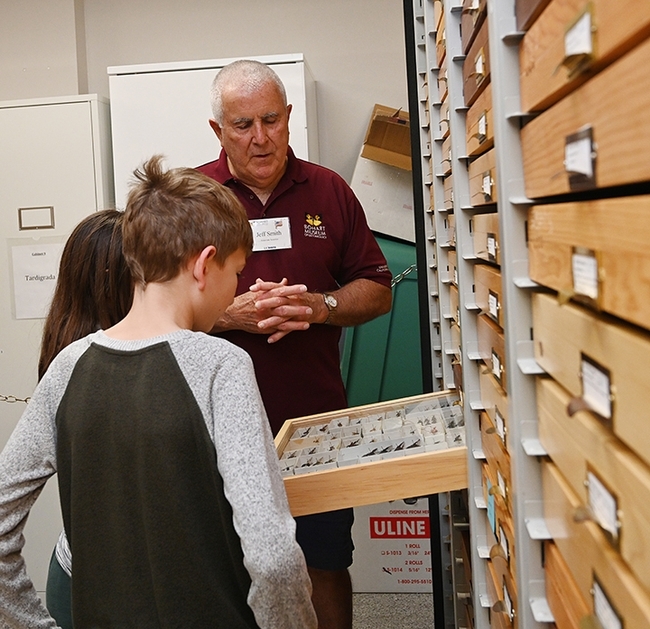
How many specimens have you spread?
“I believe I typically spread 6,000 or more moths and butterflies each year for the past 30 plus years, and at this moment, I am spreading several thousand specimens just brought back from another Belize excursion. Everything butterfly or moth that comes to the museum is handed to me to curate, label, identify, and incorporate into the collection, which I believe may now house nearly 3/4 million Lepidoptera.”
How many specimen drawers have you made?
“To date I have made and donated 2,475 drawers, and in my garage shop I am currently making another 23 as the museum suddenly became short on empty drawers. About 1/4 of the drawers have been out of repurposed redwood from old decks and fencing.
Estimated number of hours you've donated to the Bohart?
“This is difficult to say, as most of the work I do is at home (Rocklin) on a daily basis, perhaps 2 to 3 hours each day. I get into the museum once a week to put away what I've done at home, so 9 to 10 hours there as well. Even on vacations away from home I take projects to work on daily on my computer-- spreadsheets, new unit tray labels, new pull tab labels, so that adds many more hours as well, and I've been doing this for 35 years.”
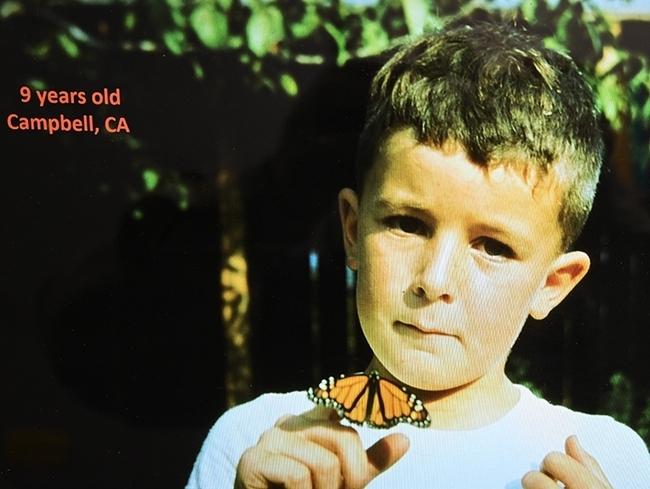
Smith is an active member of the international Lepidopterists' Society (since 1967). He and his colleagues hosted the 2019 meeting of the Lepidopterists' Society in Davis.
Now, back to "The Gold Standard."
"The Gold Standard” praise came from Professor Paul Opler (1938-2023) of Colorado State University, an international authority on Lepidoptera and author of noted books on butterflies and moths, including the Peterson Field Guide to Butterflies of Eastern North America, the Peterson Field Guide to Butterflies of Western North America, Butterflies East of the Great Plains: An Illustrated Natural History, and Moths of Western North America. butterflies. Opler (who by the way, served as the first editor of American Entomologist, published by the Entomological Society of America), received his doctorate in entomology in 1970 from UC Berkeley,
“About 10 years ago, Paul spent a few days in the Bohart going through our Notodontidae collection in preparation for a revision of that family now available,” Smith recalled. Upon returning home, Opler emailed Smith: “I consider the Bohart Lepidoptera collection to be The Gold Standard to which we all should aspire.”
“That huge compliment," Smith said, "spoke to the time I have spent with this magnificent collection."
Attached Images:

Jeff Smith, curator of the Bohart Museum of Entomology's Lepidoptera collection, chats with visitors at an open house. (Photo by Kathy Keatley Garvey)

Legendary Lepidopterists Paul Opler (left) and Robert Michael Pyle, founder of the Xerces Society for Invertebrate Conservation, chat during the international Lepidopterist Society’s 68th annual conference (2019) that included visits to the Bohart Museum. Opler, who died last year, considered the Bohart Museum Lepidoptera collection "The Bold Standard" of Lep collections. (Photo by Kathy Keatley Garvey)